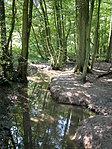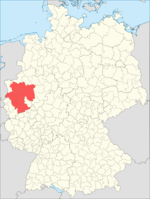Mülheim (Ruhr) Hauptbahnhof

Mülheim (Ruhr) Hauptbahnhof is a railway station for the city of Mülheim in the German state of North Rhine-Westphalia. It was renamed as a Hauptbahnhof in 1974 at the time of the rebuilding of the Dortmund–Duisburg line as part of the establishment of the Rhine-Ruhr S-Bahn. It is classified by Deutsche Bahn as a category 3 station.The original station is unusual in that it was built as two adjoining stations by the two main private railways buildings lines in the Ruhr area, the Rhenish Railway Company (Rheinische Eisenbahn-Gesellschaft, RhE) and the Bergisch-Märkische Railway Company (Bergisch-Märkische Eisenbahn Gesellschaft, BME).
Excerpt from the Wikipedia article Mülheim (Ruhr) Hauptbahnhof (License: CC BY-SA 3.0, Authors, Images).Mülheim (Ruhr) Hauptbahnhof
Parallelstraße, Mülheim an der Ruhr Eppinghofen (Rechtsruhr-Süd)
Geographical coordinates (GPS) Address Nearby Places Show on map
Geographical coordinates (GPS)
| Latitude | Longitude |
|---|---|
| N 51.431388888889 ° | E 6.8863888888889 ° |
Address
Mülheim (Ruhr) Hauptbahnhof
Parallelstraße
45468 Mülheim an der Ruhr, Eppinghofen (Rechtsruhr-Süd)
North Rhine-Westphalia, Germany
Open on Google Maps









